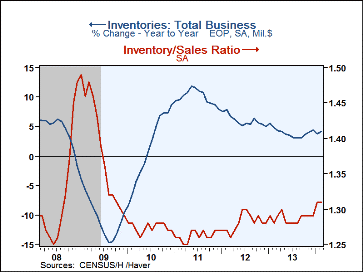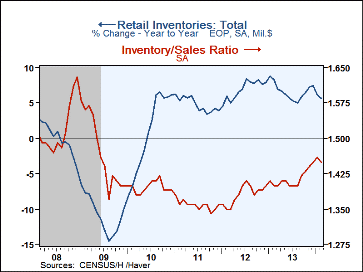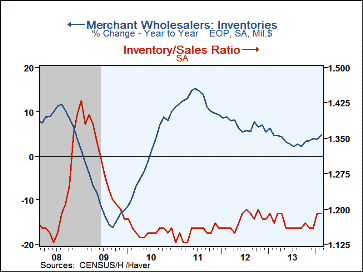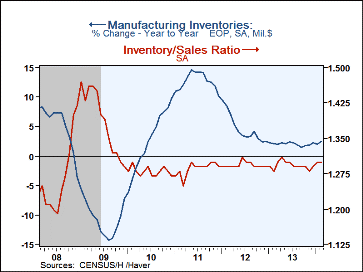 Global| Apr 14 2014
Global| Apr 14 2014U.S. Business Inventory Increase is Stable and Firm
by:Tom Moeller
|in:Economy in Brief
Summary
Total business inventories increased 0.4% in February (4.2% y/y), the same as in January. These gains were accompanied a 0.8% rebound (1.8% y/y) in business sales after January's 1.1% decline. As a result, the inventory-to-sales ratio [...]
Total business inventories increased 0.4% in February (4.2% y/y), the same as in January. These gains were accompanied a 0.8% rebound (1.8% y/y) in business sales after January's 1.1% decline. As a result, the inventory-to-sales ratio held at 1.31, the highest level since 2009.
In the retail sector, inventories remained unchanged (5.7% y/y) in February. Retail inventories excluding autos rose 0.2% (3.5% y/y). Inventories of furniture, electronics and appliances jumped 2.8% (-1.1% y/y) and clothing inventories were off 0.7% (+2.3% y/y). Motor vehicle inventories slipped 0.3% (+10.4% y/y) but furniture & home furnishing inventories jumped 2.8% (-1.1% y/y). Building materials inventories ticked 0.1% higher (2.6% y/y). The I/S ratio in the retail sector declined to a still-high 1.45, nearly its highest level since 2009. The nonauto I/S ratio was 1.24 for the third consecutive month, near its highest since early 2011.
Merchant wholesale inventories posted a 0.5% rise (4.7% y/y). That left the I/S ratio at 1.19, up off its least but below the highs of 2012. Nondurable goods distributors inventories ticked 0.1% higher (2.9% y/y). Durable wholesale inventories jumped 0.7% (5.9% y/y). That left the overall wholesale I/S ratio stable at 1.19. Factory sector inventories increased a quickened 0.7% (2.5% y/y) but the I/S ratio was stable at 1.30.
Business sales rebounded 0.8% (1.8% y/y). Merchant wholesale sales gained 0.7% (3.1% y/y) as petroleum sales rebounded 4.0% (6.7% y/y). Retail sales rose a strengthened 0.7% (1.8% y/y) but excluding autos sales gained a lesser 0.3% (0.9% y/y). Shipments from the factory sector rebounded 0.9% (0.9% y/y) and made up January's decline.
The manufacturing and trade data are in Haver's USECON database.
Updated Budget Projections: 2014 to 2024 from the Congressional Budget Office can be found here.
| Manufacturing & Trade (%) | Feb | Jan | Dec | Feb Y/Y | 2013 | 2012 | 2011 |
|---|---|---|---|---|---|---|---|
| Business Inventories | 0.4 | 0.4 | 0.5 | 4.2 | 4.4 | 5.1 | 7.9 |
| Retail | 0.0 | 0.3 | 0.7 | 5.7 | 7.4 | 7.8 | 3.9 |
| Retail excl. Motor Vehicles | 0.2 | 0.5 | 0.6 | 3.5 | 4.5 | 3.1 | 3.6 |
| Merchant Wholesalers | 0.5 | 0.8 | 0.2 | 4.7 | 4.0 | 5.5 | 9.2 |
| Manufacturing | 0.7 | 0.2 | 0.5 | 2.5 | 2.3 | 2.4 | 10.2 |
| Business Sales (%) | |||||||
| Total | 0.8 | -1.1 | -0.0 | 1.8 | 3.5 | 4.6 | 10.9 |
| Retail | 0.7 | -0.7 | -0.2 | 1.6 | 4.4 | 5.1 | 7.7 |
| Retail excl. Motor Vehicles | 0.3 | -0.2 | 0.3 | 2.3 | 3.2 | 4.5 | 7.1 |
| Merchant Wholesalers | 0.7 | -1.8 | 0.4 | 3.1 | 4.3 | 4.8 | 12.4 |
| Manufacturing | 0.9 | -0.7 | -0.3 | 0.8 | 2.0 | 4.0 | 12.1 |
| I/S Ratio | |||||||
| Total | 1.31 | 1.31 | 1.29 | 1.28 | 1.29 | 1.29 | 1.27 |
| Retail | 1.45 | 1.46 | 1.45 | 1.40 | 1.41 | 1.38 | 1.36 |
| Retail Excl. Motor Vehicles | 1.24 | 1.24 | 1.24 | 1.21 | 1.22 | 1.21 | 1.23 |
| Merchant Wholesalers | 1.19 | 1.19 | 1.16 | 1.17 | 1.17 | 1.18 | 1.15 |
| Manufacturing | 1.30 | 1.30 | 1.29 | 1.28 | 1.29 | 1.29 | 1.29 |
Tom Moeller
AuthorMore in Author Profile »Prior to joining Haver Analytics in 2000, Mr. Moeller worked as the Economist at Chancellor Capital Management from 1985 to 1999. There, he developed comprehensive economic forecasts and interpreted economic data for equity and fixed income portfolio managers. Also at Chancellor, Mr. Moeller worked as an equity analyst and was responsible for researching and rating companies in the economically sensitive automobile and housing industries for investment in Chancellor’s equity portfolio. Prior to joining Chancellor, Mr. Moeller was an Economist at Citibank from 1979 to 1984. He also analyzed pricing behavior in the metals industry for the Council on Wage and Price Stability in Washington, D.C. In 1999, Mr. Moeller received the award for most accurate forecast from the Forecasters' Club of New York. From 1990 to 1992 he was President of the New York Association for Business Economists. Mr. Moeller earned an M.B.A. in Finance from Fordham University, where he graduated in 1987. He holds a Bachelor of Arts in Economics from George Washington University.










